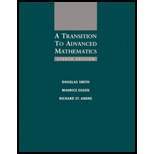
a.
Prove that the relation is an equivalence relation.
a.
Answer to Problem 6E
Equivalence Relation
Explanation of Solution
Given information:
The relation
Calculation:
Consider, the
Now check that the relation is reflexive, symmetric and transitive.
The relation is reflexive, symmetric and transitive.
Hence, this is an equivalence relation.
Equivalence class of:
b.
Find an element of
b.
Answer to Problem 6E
Equivalence Relation
Explanation of Solution
Given information:
The relation
Calculation:
Now check that the relation is reflexive, symmetric and transitive.
The relation is reflexive, symmetric and transitive.
Hence, this is an equivalence relation.
The element of
The element of
The element of
Three elements in the equivalence class
c.
Give the equivalence class of
c.
Answer to Problem 6E
Explanation of Solution
Given information:
The relation
Calculation:
Now check that the relation is reflexive, symmetric and transitive.
The relation is reflexive, symmetric and transitive.
Hence, this is an equivalence relation.
The equivalence class of :
d.
Name three elements in each of these classes:
d.
Answer to Problem 6E
Explanation of Solution
Given information:
On
Calculation:
Now check that the relation is reflexive, symmetric and transitive.
The relation is reflexive, symmetric and transitive.
Hence, this is an equivalence relation.
The equivalence class of :
e.
Describe the equivalence class of
e.
Answer to Problem 6E
Explanation of Solution
Given information:
The relation
Calculation:
Now check that the relation is reflexive, symmetric and transitive.
The relation is reflexive, symmetric and transitive.
Hence, this is an equivalence relation.
The equivalence class of :
f.
Find the number of elements in
f.
Answer to Problem 6E
Explanation of Solution
Given information:
For the set
Calculation:
Now check that the relation is reflexive, symmetric and transitive.
The relation is reflexive, symmetric and transitive.
Hence, this is an equivalence relation.
The equivalence class of :
g.
Describe all ordered pairs in the equivalence class of
g.
Answer to Problem 6E
Explanation of Solution
Given information:
The relation
Calculation:
Now check that the relation is reflexive, symmetric and transitive.
The relation is reflexive, symmetric and transitive.
Hence, this is an equivalence relation.
The equivalence class of :
h.
Name three elements in each of these classes:
h.
Answer to Problem 6E
Explanation of Solution
Given information:
Let
Calculation:
Now check that the relation is reflexive, symmetric and transitive.
The relation is reflexive, symmetric and transitive.
Hence, this is an equivalence relation.
The equivalence class of :
i.
Describe the equivalence class of
i.
Answer to Problem 6E
Explanation of Solution
Given information:
The relation
Calculation:
Now check that the relation is reflexive, symmetric and transitive.
The relation is reflexive, symmetric and transitive.
Hence, this is an equivalence relation.
The equivalence class of :
Want to see more full solutions like this?
Chapter 3 Solutions
A Transition to Advanced Mathematics
- Let G be an abelian group of order 2n, where n is odd. Use Lagranges Theorem to prove that G contains exactly one element of order 2.arrow_forwardProve or disprove that H={ hGh1=h } is a subgroup of the group G if G is abelian.arrow_forward23. Let be a group that has even order. Prove that there exists at least one element such that and . (Sec. ) Sec. 4.4, #30: 30. Let be an abelian group of order , where is odd. Use Lagrange’s Theorem to prove that contains exactly one element of order .arrow_forward
- Let A={ a,b,c }. Prove or disprove that P(A) is a group with respect to the operation of union. (Sec. 1.1,7c)arrow_forwardExercises 31. Let be a group with its center: . Prove that if is the only element of order in , then .arrow_forward16. Suppose that is an abelian group with respect to addition, with identity element Define a multiplication in by for all . Show that forms a ring with respect to these operations.arrow_forward
- True or False Label each of the following statements as either true or false. 11. The invertible elements of form an abelian group with respect to matrix multiplication.arrow_forward11. Show that is a generating set for the additive abelian group if and only ifarrow_forwardExercises 22. Let be a finite cyclic group of order with generators and . Prove that the mapping is an automorphism of .arrow_forward
 Elements Of Modern AlgebraAlgebraISBN:9781285463230Author:Gilbert, Linda, JimmiePublisher:Cengage Learning,
Elements Of Modern AlgebraAlgebraISBN:9781285463230Author:Gilbert, Linda, JimmiePublisher:Cengage Learning,
